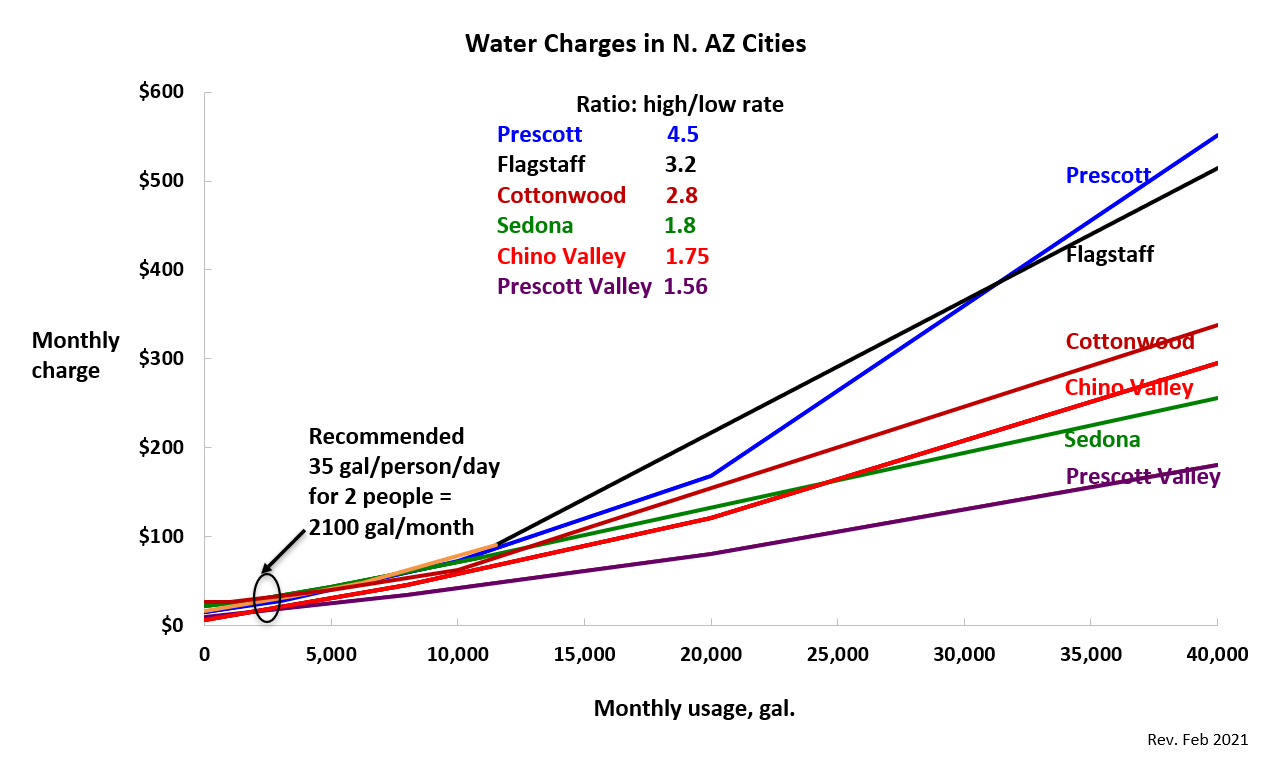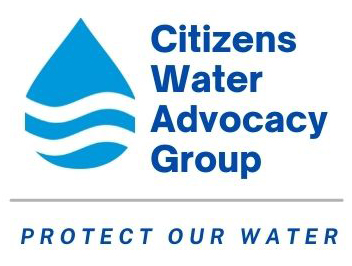Conservation Efforts in Prescott AMA
Conservation efforts in the Prescott AMA vary widely.
Yavapai County, Chino Valley, Prescott Valley, and Prescott have required water conserving features in new construction through adopting portions of the Uniform Building Code.
Prescott has by far the best conservation program in the Prescott AMA. Prescott has an excellent web site with information on conserving landscape water. Prescott has a program to incentivize homeowners to upgrade landscaping and interior fixtures. City codes require new development to use drought-tolerant plants and to use water-efficient interior fixtures. Prescott has an aggressive block-rate billing policy that strongly increased the cost of water for high-volume users.
Prescott Valley and Chino Valley have no incentive programs, a weak block-rate billing structure, and minimal public information on their website.
Yavapai County has no conservation policies other than the Uniform Building Code.

The tables below summarize regional water conservation policies in effect as of September, 2020. The conservation glossary gives brief descriptions of the policies.
-
Interior Conservation Policy
Interior Conservation Policy
Interior Water Conservation Policy in the Prescott AMA
Conservation efforts in the Prescott AMA vary widely. The tables below summarize regional water conservation policies in effect as of September, 2020. The conservation glossary gives brief descriptions of the policies.

Conservation Glossary:
Potable GPCD: Gallons per person per day of potable water provided by a municipal utility.
Conservation Plan: A document adopted by the water provider that describes water conservation programs, budgets, staffing, and a gpcd goal with usage milestones. Typically the plan, prepared with public and stakeholder input, looks forward 10 years and is updated periodically.
Educational Messaging: A program of public information outreach informing the public how to conserve water and why it is important. May involve broadcast and print media plus inserts in utility bills.
Residential Water Audit: A program (typically free) where the water provider reviews the past consumption of a home and suggests ways to use less water.
Commercial Water Audit: A program (typically free) where the water provider reviews the past consumption of a business and suggests ways to use less water. Normally this involves a site visit.
Retrofit on Resale: A legal requirement that, upon sale to a new owner,a home or business property must upgrade fixtures and processes to meet current code.
Tiered Rates: A utility billing rate structure where greater water use faces higher water rates. Typically the water rates are grouped into tiers. The first tier, a few thousand gallons, is inexpensive, the next tier is more expensive, etc.
Conservation Plumbing Code: City and County building departments regulate structures by adopting some version of the Uniform Building Code. This national code requires use of efficient plumbing fixtures (toilets, etc).
HE Toilet Incentive: A water supplier provides an incentive grant to a property owner for upgrading an inefficient older toilet (up to 5 gallons/flush) with a high efficiency toilet (now dual flush, 0.8/1.2 gallons/flush).
HE Toilet Incentive - Septic: Same as HE Toilet Incentive with a higher payment to provide extra incentive in order to reduce the amount of water lost to the wastewater/recharge system by the septic system.
HE Laundry: A water supplier provides an incentive grant to a property owner for upgrading an inefficient older laundry machine (up to 50 gallons/cycle) with a high efficiency appliance (often 12 gallons/cycle).
HE Laundry - Septic: Same as HE Laundry Incentive with a higher payment to provide extra incentive in order to reduce the amount of water lost to the wastewater/recharge system by the septic system.
Hot Water Recirculation: A small pump on a timer switch circulates hot water through the supply line of selected faucets. This permits hot water to immediately flow and eliminates wasting cold water while waiting for hot water to flow to the faucet.
Waterless Urinal Replacement: Incentive for facility operators to replace urinals using water (about 1 gallon/flush) with a waterless fixture.
High Water Use Notice: A program where the water utility notifies a user when abnormally high water use is detected. Useful for leak detection.
Offset Program: A program granting water to a subdivision developer if they finance community conservation actions that will save the amount of water they are awarded.
-
Exterior Water Use Policy
Exterior Water Use Policy
Exterior Water Conservation Policy in the Prescott AMA
Conservation efforts in the Prescott AMA vary widely. The tables below summarize regional water conservation policies in effect as of September 2020. The conservation glossary gives brief descriptions of the policies.
Conservation Glossary:
Seasonal Water Use: The percentage of total potable water use in excess of a base water use determined by the average use for the three lowest months of a year.
Landscaping Site Plan: For new construction, a plan showing the location, number, and species of landscape plants.
Landscaping Species Requirement: A policy restricting the type of plants that may be used on a new development, often specifying drought-tolerant or native plants.
Turf Restriction: A policy limiting the turf area in a landscape.
Turf Removal Incentive: A policy providing payment to a property owner for removing turf and converting to a low water use landscape.
Irrigation with Recycled Water: Use of treated wastewater for outdoor irrigation, usually for golf courses.
Time of Day Restriction: Prohibits overhead watering during specific times, or limits outdoor watering to specific days of the week.
Active Rainwater Harvesting: An incentive to property owners to recover rainwater from roofs and store it in tanks for landscape use.
Passive Rainwater Harvesting: An incentive to property owners to utilize passive rainwater harvesting techniques. Passive water harvesting is the practice of shaping the landscape surface to catch and direct stormwater runoff to landscape plantings.
Water Sense Irrigation Timer: An electronic device that uses rain and soil moisture sensors to activate scheduled landscape irrigation.Outdoor use of Potable Water Prohibited: Regulation prohibits outdoor use of potable water delivered by a water provider.
Graywater Use: Water collected from shower, laundry (unless diapers are washed), and sinks can be used to irrigate ornamental outdoor plants; use of sprinklers and collection from kitchen sink drains is prohibited.
Offset Program: A program granting water to a subdivision developer if they finance community conservation actions that will save the amount of water they are awarded.
Stormwater Collection & Recharge: A program requiring residential subdivisions and commercial and industrial properties to collect stormwater from roofs and streets for permanent recharge to the aquifer.
